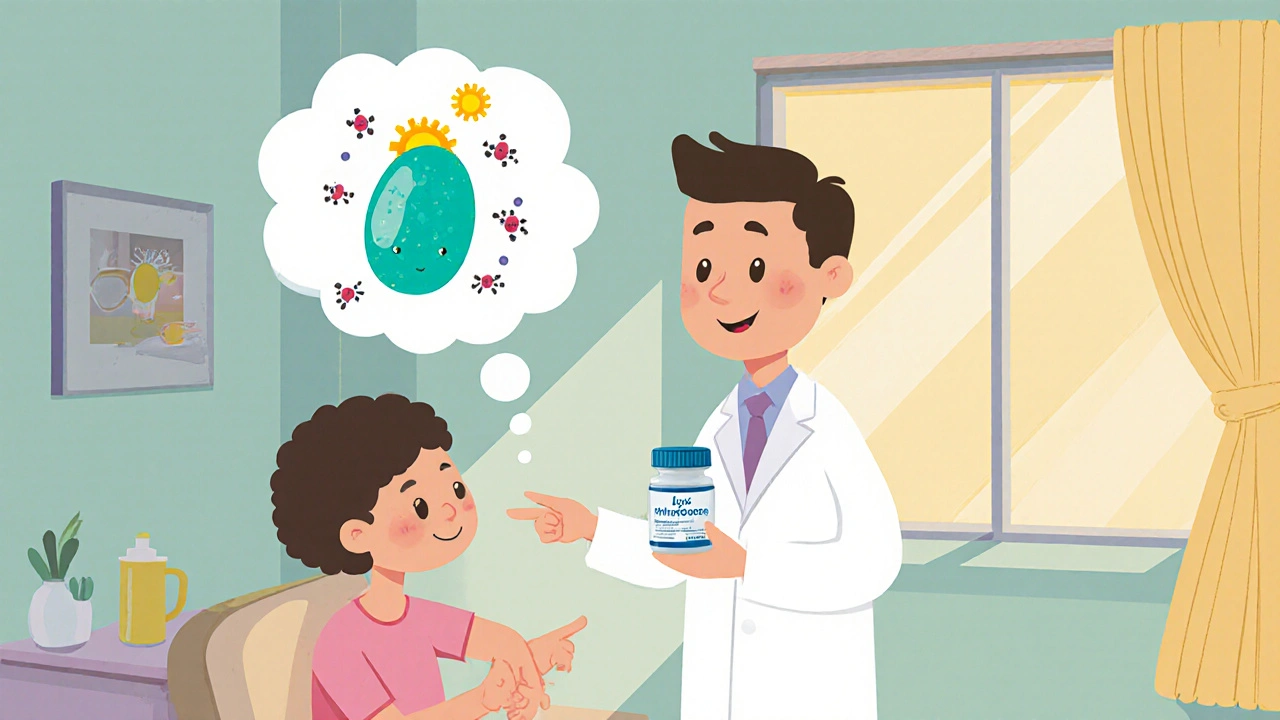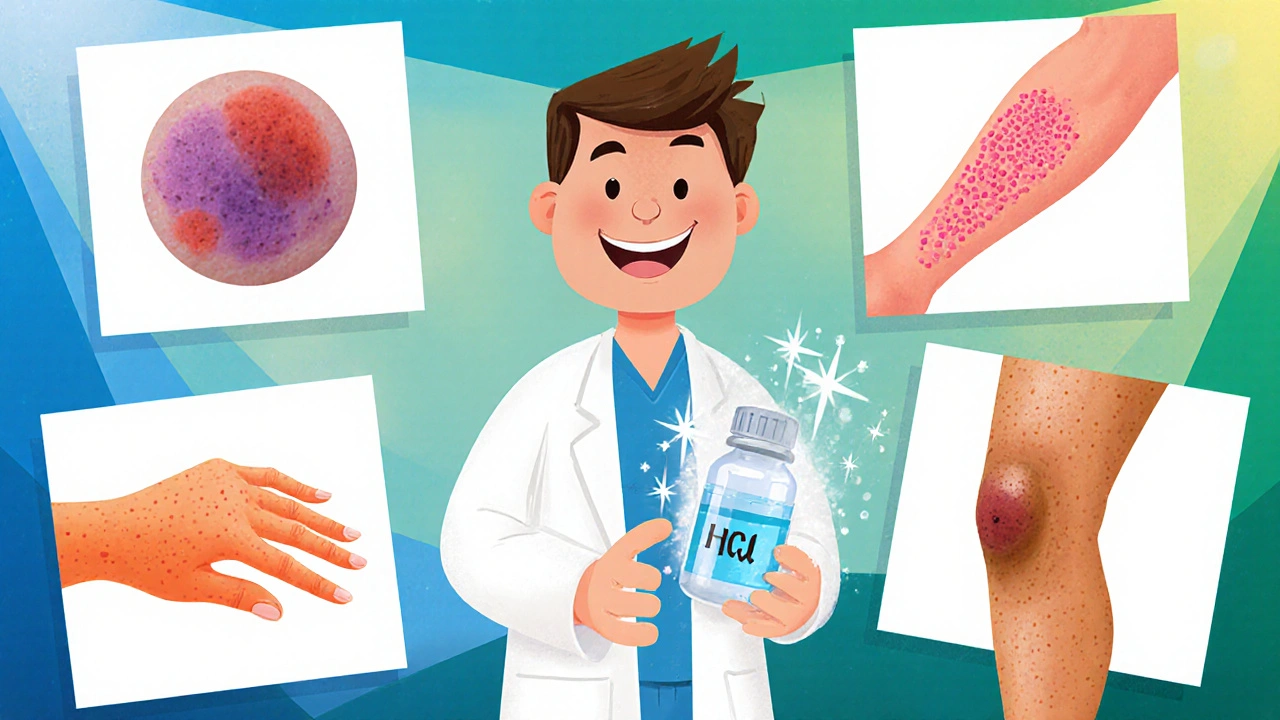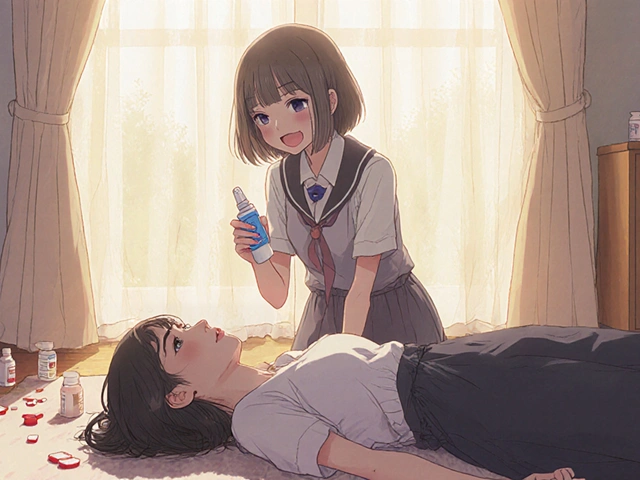
Hydroxychloroquine Dosing Calculator
Calculate the appropriate hydroxychloroquine dose based on patient weight. For patients under 50 kg, use 3 mg/kg/day. Maximum dose should not exceed 400 mg/day. Doses above 5 mg/kg/day increase risk of retinal toxicity.
Recommended Dose
Important Safety Notes:
- Maximum daily dose should not exceed 400 mg
- Baseline ophthalmic exam required before starting
- Annual eye exams recommended after first year of therapy
- Dose should not exceed 5 mg/kg of ideal body weight
When a dermatologist reaches for a systemic drug, the goal is to calm the immune system without causing new problems. hydroxychloroquine fits that bill for a surprising number of inflammatory skin diseases, yet many clinicians still wonder when and how to use it safely. This guide walks you through the science, the approved and off‑label indications, practical dosing tips, and the safety checkpoints that keep patients’ eyes and hearts out of trouble.
How Hydroxychloroquine is an antimalarial drug that modulates immune activity by raising lysosomal pH and interfering with antigen presentation works in the skin
Hydroxychloroquine (HCQ) is not a steroid, but it still dampens the overactive immune response that drives rash and tissue damage. By increasing the pH inside lysosomes, HCQ hinders the processing of auto‑antigens, which reduces the activation of T‑cells and downstream cytokine release. The effect is gradual - most patients notice improvement after 6-12 weeks - but the low‑grade immunosuppression is usually enough to keep chronic rashes under control.
Skin conditions where HCQ is the drug of choice (or a strong contender)
- Cutaneous lupus erythematosus encompasses discoid lupus and subacute cutaneous lupus, characterized by photosensitive plaques and papules. HCQ is first‑line for both discoid and subacute forms, with response rates of 70‑80% in modern series.
- Dermatomyositis presents with Gottron’s papules and heliotrope rash; systemic involvement is common. HCQ helps skin lesions when steroids are tapered.
- Polymorphous light eruption (PLE). The drug’s photoprotective effect reduces the frequency of seasonal flares.
- Porphyria cutanea tarda. Low‑dose HCQ accelerates the clearance of porphyrins.
- Sarcoidosis with cutaneous nodules. HCQ can shrink granulomatous lesions while sparing patients from high‑dose steroids.
These five conditions account for the bulk of dermatology prescriptions of HCQ, and the evidence base has grown steadily since the early 2000s.
Typical dosing and how to start a patient
Adults usually start at 200mg once or twice daily, never exceeding 400mg per day. Weight‑based adjustments are common for patients under 50kg - a dose of 3mg/kg/day is a safe ceiling. The drug is taken with food to lessen stomach upset.
Because HCQ’s steady‑state concentration takes 4-6 weeks to build, clinicians should set realistic expectations: “You may not see a clear difference until the second month, but that’s normal.” A baseline ophthalmic exam is mandatory before the first dose.

Safety monitoring: the eyes, the heart, and the labs
Retinal toxicity remains the headline safety concern. The risk climbs after five years of continuous use or if the daily dose exceeds 5mg/kg of ideal body weight. Modern screening uses spectral‑domain optical coherence tomography (SD‑OCT) and automated visual field testing. The FDA requires a baseline eye exam and annual follow‑ups after the first year of therapy recommends follow‑up every 12 months for high‑risk patients and every 2-3 years for low‑risk users.
Cardiac monitoring is less frequent but still advised for patients with pre‑existing heart disease. HCQ can cause a reversible cardiomyopathy, so an annual ECG is a prudent precaution for anyone on therapy longer than 3years.
Routine labs should include complete blood count, liver enzymes, and renal function every 3-6 months. If the patient develops new GI symptoms, a dose reduction can often resolve the issue without losing efficacy.
HCQ versus other systemic agents: when to choose one over the other
| Attribute | Hydroxychloroquine | Methotrexate |
|---|---|---|
| Typical dose | 200‑400mg daily | 7.5‑25mg weekly |
| Time to noticeable effect | 6‑12 weeks | 4‑8 weeks |
| Common side effects | Retinal toxicity, GI upset | Liver elevation, mouth sores, pulmonary fibrosis (rare) |
| Monitoring required | Annual eye exam, ECG after 3years | LFTs monthly, CBC, pregnancy test |
| Pregnancy safety | Category D, used cautiously | Contra‑indicated |
Both drugs are effective, but HCQ wins for patients who need a milder immunomodulator, who have photosensitivity, or who are planning a pregnancy (despite its CategoryD label, many obstetricians consider it acceptable when benefits outweigh risks). Methotrexate is preferred for rapid control of severe plaque psoriasis or when the rash is unresponsive after three months of HCQ.

Practical tips for clinicians prescribing HCQ
- Screen for pre‑existing retinal disease or macular degeneration before the first dose.
- Calculate the dose based on ideal body weight, not actual weight, to keep the mg/kg ratio below 5mg.
- Educate patients to report any visual changes immediately - even subtle blurring can be an early sign.
- Schedule the first ophthalmology appointment within 6months of starting therapy, then follow the FDA‑recommended interval.
- For patients with chronic kidney disease, reduce the dose by 25‑50% and monitor renal labs closely.
- If a patient needs to stop HCQ abruptly (e.g., due to toxicity), taper over 2‑4 weeks to avoid a flare of the underlying skin disease.
These steps keep the balance between efficacy and safety, letting clinicians harness HCQ’s benefits without unnecessary risk.
Frequently Asked Questions
Can hydroxychloroquine cure cutaneous lupus?
It rarely cures the disease outright, but it controls skin lesions in 70‑80% of patients, reduces scarring, and allows steroid tapering.
How often should eye exams be done?
A baseline exam before starting, then annually after the first year for most patients. High‑risk users (dose >5mg/kg, >5years of therapy) need exams every 6‑12 months.
Is HCQ safe during pregnancy?
Hydroxychloroquine is classified as CategoryD, but many rheumatologists continue it in lupus pregnancies because the benefits of disease control outweigh the potential fetal risk.
What are the early signs of retinal toxicity?
Patients may notice difficulty reading fine print, loss of peripheral vision, or changes in color perception. Early OCT changes can appear before symptoms.
Can hydroxychloroquine be used for acne?
There’s limited evidence; it’s not a standard therapy for acne. For inflammatory acne, antibiotics or retinoids are preferred.





There are 6 Comments
Richard O'Callaghan
I've actually seen hydroxychloroquine work wonders in a patient with discoid lupus who couldn't tolerate steroids, and we had to adjust the dose after a few weeks because of mild GI upset. The eye exam was scheduled earlier than usual, and the results came back clean, which gave us confidence to keep going. It's important to remember that the drug can take up to three months to show full effect, so patience is key. Also, keep an eye on the labs every couple of months, especially if the patient has kidney issues, otherwise you might miss a subtle change. Honestly, I definately think the benefits often outweigh the risks when you follow the monitoring protocol.
Alexis Howard
Hydroxychloroquine is overrated and you can manage most skin conditions with cheaper options.
Steve Holmes
Hey folks, I love how HCQ offers a gentle alternative to steroids, especially for photosensitive rashes, and the dosing schedule is pretty straightforward-just 200 mg once or twice daily with food, which helps with stomach tolerance, and the gradual improvement over 6‑12 weeks is something many patients appreciate, right? Plus, the eye screening protocol has become so much easier with SD‑OCT, making early detection less scary, and the overall safety profile is solid when you keep an eye on the weight‑based limits!
Tom Green
For anyone just starting out with HCQ, remember to calculate the dose based on ideal body weight rather than actual weight-this keeps you under the 5 mg/kg threshold that reduces retinal toxicity risk. Also, schedule that baseline ophthalmology visit within the first six months; catching any early changes can make a huge difference down the line. If the patient reports any visual disturbances, even mild blurring, act fast and consider adjusting the dose. And don’t forget routine labs-CBC, liver enzymes, renal function-every three to six months to stay ahead of potential side effects.
Kate Marr
From a US practice standpoint, HCQ has been a staple for lupus skin disease, and our clinics have seen a drop in steroid dependence after introducing it. The retinal screening guidelines are clear, and most patients tolerate the protocol well 😊. Make sure you’re using the ideal body weight formula to stay under the recommended mg/kg ceiling.
James Falcone
Honestly, I’ve seen too many docs jump straight to methotrexate without giving HCQ a fair trial, and that’s a waste of a safe, cheap option we have made in America.
Write a comment
Your email address will not be published. Required fields are marked *